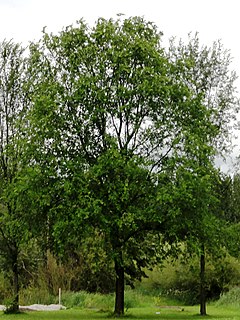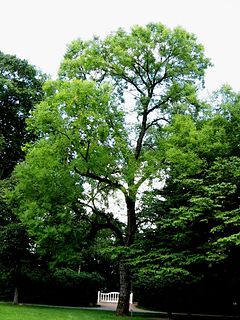Related Research Articles

Ulmus pumila, the Siberian elm, is a tree native to Central Asia, eastern Siberia, the Russian Far East, Mongolia, Tibet, northern China, India and Korea. It is also known as the Asiatic elm and dwarf elm, but sometimes miscalled the 'Chinese Elm'. It is the last tree species encountered in the semi-desert regions of central Asia. Described by Pallas in the 18th century from specimens from Transbaikal, Ulmus pumila has been widely cultivated throughout Asia, North America, Argentina, and southern Europe, becoming naturalized in many places, notably across much of the United States.
The hybrid elm cultivar Ulmus × intermedia 'Coolshade' is an American hybrid cultivar cloned from a crossing of the Slippery, or Red, Elm Ulmus rubra and the Siberian Elm Ulmus pumila at the Sarcoxie Nurseries, Sarcoxie, Missouri, in 1946. At Arnold Arboretum, where there was a specimen, herbarium material was labelled Ulmus pumila 'Coolshade'.
The Siberian elm cultivar Ulmus pumila 'Green King' was once believed to have been derived from a crossing of the Siberian Elm Ulmus pumila with the American Red Elm Ulmus rubra. However, it is now apparent the tree originated as a sport of U. pumila in 1939 at the Neosho Nurseries, Neosho, Missouri.
The Siberian elm cultivar Ulmus pumila 'Chinkota' is from a seed-produced line of extremely cold-hardy and drought-resistant trees raised in the United States. The tree was developed from seed of the cultivar 'Dropmore' by the Horticulture & Forestry Department of South Dakota State University after World War II

The Siberian elm cultivar Ulmus pumila 'Hansen' is a little-known American tree of obscure origin, possibly raised from seed collected by the horticulturist and botanist Prof. Niels Hansen during his expedition to Siberia in 1897.
The Siberian Elm cultivar Ulmus pumila 'Park Royal' is a cold-hardy selection raised by the Sheridan Nursery, Toronto, Ontario, Canada.
The Siberian Elm cultivar Ulmus pumila 'Manchu' was raised by Stewarts Nurseries, Sutherland, Saskatchewan, c. 1951 from seed collected by Mr Ptitsin from near Harbin, China.

The hybrid elm cultivar Ulmus 'Den Haag' is a Dutch development derived from a chance crossing of the Siberian Elm cultivar Ulmus pumila 'Pinnato-ramosa' and the Belgian Elm Ulmus × hollandica 'Belgica'. S. G. A. Doorenbos (1891-1980), Director of Public Parks in The Hague, finding that seeds he had sown in 1936 from the Zuiderpark 'Pinnato-ramosa' had hybridized with the local 'Belgica', selected six for trials. The best was cloned and grafted on 'Belgica' rootstock as 'Den Haag'; it was planted first in that city, then released to nurseries elsewhere in the Netherlands. The other five were also planted in The Hague.

The Siberian Elm cultivar Ulmus pumila 'Pendula' is from northern China, where it is known as Lung chao yü shu. It was classified by Frank Meyer in Fengtai in 1908, and introduced to the United States by him from the Peking Botanical Garden as Weeping Chinese Elm. The USDA plant inventory record (1916) noted that it was a "rare variety even in China". It was confirmed as an U. pumila cultivar by Krüssmann (1962).
The hybrid elm cultivar Ulmus 'Hamburg' was originally raised by the Plumfield Nurseries, Fremont, Nebraska, circa 1932, after its discovery by Mr. Lloyd Moffet in a bed of Siberian Elm Ulmus pumila seedlings from Tekamah. It was later marketed by Interstate Nurseries, Hamburg, Iowa, in 1948, and claimed to be a hybrid of Ulmus pumila and Ulmus americana. However it is now considered more likely that Ulmus rubra was the male parent.
The hybrid elm cultivar Ulmus × intermedia 'Willis' originated as a crossing made by a Mr Minnick of Kansas. Almost certainly derived from a crossing of the Siberian Elm Ulmus pumila and the Red Elm Ulmus rubra, it was originally believed that the male parent was the American Elm Ulmus americana.

The hybrid cultivar Ulmus 'Androssowii'R. Kam., an elm of Uzbekistan sometimes referred to in old travel books as 'Turkestan Elm' or as 'karagach' [:black tree, = elm], its local name, is probably an artificial hybrid. According to Lozina-Lozinskaia the tree is unknown in the wild in Uzbekistan, and apparently arose from a crossing of U. densa var. bubyrianaLitv., which it resembles, and the Siberian Elm Ulmus pumila.

Ulmus 'Recerta' is an American hybrid cultivar raised by the Wisconsin Alumni Research Foundation (WARF) as selection '196-5' from seed obtained from a Siberian Elm Ulmus pumila in Volgagrad, Russia; the male parent deduced as the Field Elm Ulmus minor.
Ulmus 'Repura' is an American elm cultivar raised by the Wisconsin Alumni Research Foundation (WARF) as selection '1193-4', derived from a crossing of 'Regal' and a crossing of Ulmus rubra with the hybrid Ulmus pumila × Ulmus davidiana var. japonica.
Ulmus 'Revera' is an American hybrid cultivar raised by the Wisconsin Alumni Research Foundation (WARF) as selection '1193-3' which, like 'Reperta', was derived from a crossing of 'Regal' with a crossing of Ulmus rubra and the hybrid Ulmus pumila × Ulmus davidiana var. japonica.

The Siberian elm cultivar Ulmus pumila 'Pinnato-ramosa' was raised by Georg Dieck, as Ulmus pinnato-ramosa, at the National Arboretum, Zöschen, Germany, from seed collected for him circa 1890 in the Ili valley, Turkestan by the lawyer and amateur naturalist Vladislav E. Niedzwiecki while in exile there. Litvinov (1908) treated it as a variety of Siberian elm, U. pumilavar.arborea but this taxon was ultimately rejected by Green, who sank the tree as a cultivar: "in modern terms, it does not warrant recognition at this rank but is a variant of U. pumila maintained and known only in cultivation, and therefore best treated as a cultivar". Herbarium specimens confirm that trees in cultivation in the 20th century as U. pumilaL. var. arboreaLitv. were no different from 'Pinnato-ramosa'.
The hybrid elm cultivar Ulmus × intermedia 'Improved Coolshade' is a superior selection from 'Coolshade' and was patented and released by the Sarcoxie Nurseries, Sarcoxie, Missouri, United States, in 1958.
The Japanese Elm cultivar Ulmus davidianavar.japonica 'Reseda' is an American cultivar raised by the Wisconsin Alumni Research Foundation (WARF) as clone no. 43-8. 'Reseda' was grown from seed sent from Hokkaido, Japan, in the late 1950s. Although not released in its own right, it was destined to become the female parent of the highly successful hybrid cultivars 'New Horizon' and 'Rebona'.

The Siberian elm cultivar Ulmus pumila 'Poort Bulten' hails from Arboretum Poort Bulten in Losser, Netherlands. This tree was for many years mistaken for Planera aquatica or 'water elm' and commercially propagated under that name.
References
- ↑ Dirr, M. A. (1990), Manual of woody landscape plants, Ed. 4, p. 882, 1990
- ↑ Santamour, Frank S.; Bentz, Susan E. (May 1995). "Updated Checklist of Elm (Ulmus) Cultivars for use in North America". Journal of Arboriculture. 21 (3): 122–131. Retrieved 20 June 2016.